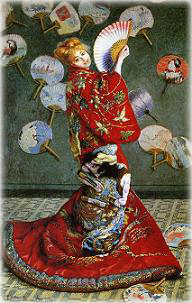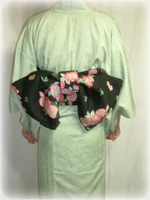Japanese Goods, flowing scents
from the traditional culture in Japan.
Pick up Items
Site Info
This is a free web app. Webアプリ
Add this button to your bookmark.
How to wear a kimono, Top page
Learn from a simple way to a formal way of wearing a kimono
Frist, enjoy a kimono simply
First, we recommend you to enjoy a kimono simply. There are many inexpensive kimonos you can purchase at online stores even if you are in abroad. A yukata is simple and easy to wear, and also inexpensive, so it is good for the first try. If you would like to wear a kimono itself, we recommend you to get a washable type, an easy wearing type (usually called "Nibushiki Kimono"), or an used one. A nice used kimono can be used for a gown like a right image, because it has a very nice silk texture on the back fabric. Fling it on and tie the front of a kimono simply by a sash, a Koshihimo.
For men, we also recommend Jinbe, which is worn at home, or Samui, which is worn by a craftsman at work.
How to wear a yukata
Yukata is the most casual kimono which was used for a bathrobe in the Edo period. Even today, you can use a yukata for a robe with tying the front by a sash. If you use an obi to tie the front of a yukata neatly, you can go outside in the summer, or if your country's climate is hot, any days.
A way to wear a yukata with an obi is the same method in the following "How to wear a kimono" and "How to tie an obi". When you wear a yukata, you can skip a step of wearing Nagajuban: Step 2. in "How to wear a kimono".
How to wear a kimono, a basic way
In the beginning, it is important to wear a kimono in a basic way without complicated methods or accessories. Formal kimono dresses are beautiful, but it needs many tips to wear them elegantly as well as (or more than) European dresses. In addtion to it, today there are many accessories to wear a kimono dress neatly. To collect these accessories from abroad may be tiring work, so at first please challenge a basic way to wear a kimono casually without various accessories. If you would like to know ways of using those accessories, please refer How to use kimono accessories.
In the following "How to wear a kimono" and "How to tie an obi", you can wear a kimono all by yourself with minimum items. You only need a hadajuban, a nagajuban, three koshihimo sashes, a kimono (a nagagi), and an obi. (a extra item: a pair of tabi socks).
These are directions for ladies, if you would like to know men's directions, please refer the external sites, for examples, SAGAMI in Japanese, kimono.net in Japanese. These external sites are both in Japanese, but they have plenty of illustrations, so will help you much.
FYI: There are numberless ways to tie an obi as like hair styles. The bases are in the three types, Chyo Musubi, Taiko Musubi, and Bunko Musubi. On these pages, we introduce Chyo Musubi for a basic way, and Taiko Musubi for a formal way to tie an obi.
How to tie an obi, a formal way
We explain Taiko Musubi for a formal and standard way of tying an obi, but this way is a little difficult, and need many accessories. You need to prepare two more koshihimo sashes, a hand towel, an obiage, an obijime, and an obimakura for this style.
 How to tie Taiko Musubi1 2 3 4 5 6
How to tie Taiko Musubi1 2 3 4 5 6


